
Tree Ring Chronologies—Are they valid?

The Scroll of Biblical Chronology and Prophecy shows that the the global deluge was in 2484 B.C., in the 1657th year after the creation of the world. After the flood, the very first new trees began to grow, so that in real time they can be no older than 4,491 years (as of A.D. 2009). The second oldest living tree so far discovered is a bristlecone pine named the "Methuselah Tree" (see possible photo at right), located in the White Mountains of California. It's location is a guarded secret. Tree researchers may have counted 4600 to 4723 rings.[1] The number given is variable due to the difficulty of seeing the millimeter thin rings, the the need to estimate the rings that could not be cored, and the tendency for initial figures to grow when hypothetical "locally absent" rings are added to make the tree cross match better with other trees. But the later figure is probably the closest to the truth that can be found for 1957.
 The interpretation of the rings is a different matter. Trees
will regularly grow sub-annual rings when environmental conditions are right. This is an added band that may be
indistinguishable from an annual ring, even under a microscope. If a
sub-annual band is counted as annual then the tree's age will be inflated.
If as few as 7% of Methuselah's rings were sub-annual, then Methuselah's age
would be less than the date of the flood in 2484 B.C. Since we
cannot go back and duplicate all the climactic and genetic conditions of the
tree, we cannot know for sure which rings are annual and which are not.
The interpretation of the rings is a different matter. Trees
will regularly grow sub-annual rings when environmental conditions are right. This is an added band that may be
indistinguishable from an annual ring, even under a microscope. If a
sub-annual band is counted as annual then the tree's age will be inflated.
If as few as 7% of Methuselah's rings were sub-annual, then Methuselah's age
would be less than the date of the flood in 2484 B.C. Since we
cannot go back and duplicate all the climactic and genetic conditions of the
tree, we cannot know for sure which rings are annual and which are not.

There is one older tree than Methuselah, called Prometheus. 4844 rings were counted[2]. In this case, the sub-annual rings must be at least 10% of the total ring count. Checking past tree ring growth is not something that can be scientifically verified. However a creation scientist, Walter Lammerts, was able to induce multiple sub-annual ring growth in Bristlecone Pine saplings (see photo above)[3]. W.E. Lammerts, a plant scientist, simulated the ancient environment of the Bristlecone Pine in greenhouse experiments. Using Paleo-climate records, Lammerts concluded that the White Mountains experienced a "San Francisco type of both spring and fall rainfall with a relatively dry period in the summer". The records also show increased snowfield cover and higher humidity content due to ancient post-flood lakes. Lammerts' experiments approximated these conditions resulting in sub-annual ring growth that was not distinguishable from the annual ring. He duplicated the longer day at high altitude with extensive snowfield to reflect light. He estimated that 50% of years could have doubled rings due to the cyclical "San Francisco" type climate before the year A.D. 1200.
Another researcher found that rings may "possess outer borders indistinguishable from the borders terminating the annual increment"[4]. This problem was recognized by Wayne Wendland as early as 1975:
"A continuing problem of dendrochronology is the identification of false or missing rings in tree cores. Their identification is essentially still a subjective, qualitative technique. Experienced workers verify false and missing rings by comparison with adjacent cores. However, conclusions are subjective and the product of experience" (Tree-Ring Bulletin).
Of course, if the false ring runs all the way around the trunk, then it will show up in all the cores and will go undetected. And that is exactly what Lammerts found. The additional sub-annual growth he demonstrated went right around the trunk of the saplings. Two to four cores are usually bored from a tree. However, in Bristlecone Pines the new growth is always on just one side of the tree in the older trees, a growth pattern called "strip-bark growth".
The original trunk dies, or mostly dies, and a strip of growth just grows on one side of the tree. This can continue for thousands of years. The original trunk usually rots to the core. It is a lot harder to detect a partial sub-annual ring, when 3/4 of the trunk radius is gone, in the innermost rings. Four cores will not help much if the original trunk is rotted. And in the Bristlecone pine a piece of core as little as 12.7 cm may contain 1100 years of rings (Ferguson). It is more likely though, that even with a full trunk the sub-annual rings normally go all the way around, and in that case there is no way to detect it. If there are any differences at the cellular level between the annual and sub-annual rings, it is doubtful that the researchers took time to unambiguously resolve this. We don't know because C.W. Ferguson never released his detailed data for outside verification.
The reason that most non-Christian dendrochronologists are confident of one annul ring per year over a period of 4000 years is that they subscribe to the philosophy of uniformitarianism. They think it is "scientific" to assume that things operated in the past as they do in the present, and so all their experiments are conducted with the assumption that current environmental conditions were the same in the past. For this reason, they only minimally verified that Bristlecone Pine grows one ring per year at present. I say minimally, because the actual 4000 year old Bristlecones in their microenvironments were not studied for multiple ring growth. Other trees at lower altitude with more access to moisture and better soil were studied. And the conclusions were not drawn from actual plottings of annual growth, but from cross-matching with assumed severe weather records and then circumstantially concluding that there was no sub-annual growth.[5] The researchers failed to test for non-uniformitarian conditions like W.E. Lammerts because they were biased by the philosophy.
Uniformitarianism is only scientific when the conditions contributing to the uniform factor remain unchanged. The problem is that secular scientists make two mistakes. One, they think that conditions have not changed despite abundant evidence they have. And two, if they think of changing conditions, they have too narrow a view of what factors might upset the uniformitarian assumption in a given case. God programmed biological organisms to respond differently when certain conditions change. Everything has its unique program and unique characteristics. That's the nature of design. There is an abundance of variety. Is it probable that one organism always behaves the same way a similar organism behaves? Assuming evolution, the answer might be yes, because blind chance will produce minimal differences more often than extreme differences in kinds that look most similar. That's because with evolution, the relatedness between two similar organisms is maximized. And we may add a third problem or mistake that even Christians can make. Our human nature always tends to assume similarity until the exception is proven. We do this when we are learning a language. We may assume uniformitarian application of a rule and then make a lot of stupid mistakes because we have not learned all the exceptions, and in some cases the exceptions are more than the rule! Order and design do not have to obey the uniformitarian philosophy. They just have to be reasonably functional and live up to the Creator's design goals.
So since God designed it all, the sum of the uniform properties that one can extrapolate from one kind to the next similar kind is totally dependent on the way the designer designed it. It could go either way. And God has shown the propensity for surprises. Things may look similar, but they may not be, and we shouldn't jump to certain conclusions without testing the matter. Think about the Bristlecone Pine. Anyone who sees a Bristlecone Pine growing in the first several hundred years of life will not witness the "strip-bark" growth that comes later on. If this persons experience is only with a young grove, he will not be able to predict the strip-bark growth that comes later when the tree's size and condition changes. It's a design parameter that only kicks in under certain special conditions that the observer may not have witnessed. Further, who would believe that scraggly old pines growing out of rock at 11,000 feet with relatively little green on them were the oldest things on earth based on their experience with old trees of other species?
Why then should a researcher assume that all sub-annual rings are fuzzy and indistinct while annual rings are sharp just because that seems to be the case in the other kinds of trees he has seen? Why should a researcher assume that these trees behave and grow the same way at all times in the past? It is one thing to innocently assume a property based on uniform behavior and find out you are either right or wrong later with little consequence. It is quite another to assume a uniform behavior, and then base a whole lot of important conclusions on it, and call them "scientific", so that should the assumption prove false, it will be revealed that the wrong conclusions have hurt a multitude of people. A child is entitled to his own mistakes. But he has to grow up and realize the consequences of mistakes before he is put in charge.
The word of the Designer is more certain than all assumptions. Clearly, at least 7% or so of the Methuselah's tree's rings are sub-annual, and at least 10% of the Prometheus tree. What counts is the biblical date of the flood at 2484 B.C. On just about any other reasonable Biblical chronology, the Prometheus tree exceeds the date of the flood. Yet the ring numbers given may reflect the addition of 5% or so "locally absent rings". The researchers really won't say. If we suppose that the matches of Methuselah and Prometheus are as poor as Pine Alpha, we may be justified in discounting the matches entirely and eliminating the 5% theoretical additional rings. In that case the minimal case for sub-annual rings goes down to 2% and 5% respectively.
The 7,104 Year White Mountain "Chronology"
C.W. Ferguson constructed a 7,104 year Bristlecone Pine chronology by linking dead wood with living trees. He never released his ring width data while he was alive. If you go to the ITRDB (International Tree Ring Data Base), you will be able to get this compilation of C.W. Ferugson's data: White Mountains Master. The file is named: ca506.crn. This is just the master chronology—basically his conclusions and no real data. If you look at a similar listing for a more recent chronology, you will see that several files are missing. Here is a typical example:
Chronology: northamerica/usa/ca566.crn
Chronology: northamerica/usa/ca566a.crn
Chronology: northamerica/usa/ca566r.crn
Correlation Stats: ca566.txt
Raw Measurements: northamerica/usa/ca566.rwl
However, I goaded an evolutionist into giving up the location of another file which clearly has Ferguson's data for its foundation, which are conveniently mislabeled. The files are listed here: Graybill - Methuselah Walk - PILO - ITRDB CA535. And the the ring width data file is specifically here: ca535.rwl. How do we know this file has Ferguson's data for its foundation? The year range is -6000 to 1979, or 7,979 years long.
--------------------------------------------
Tree's also can fail to grow a ring at all in a given year due to lack of moisture or extreme cold. This is the absent ring problem. Also, trees are known to grow multiple rings in one year if the climate is erratically wet and dry. And related to the false ring phenomenon, is the possibility that a tree may grow multiple thin rings in one season as a means of dealing with low moisture. The thin ring helps the tree retain water.
If this tree began to grow at the end of the flood year, then a significant percentage of the rings must be non-annual rings. Possibly these trees grow multiple narrow rings in very dry years to conserve water. Or, as one creation scientist experimentally showed, seedlings of this species, like many other species, can grow multiple rings per year when subjected to drought conditions for a period of time. Researchers have not done sufficient experiments, nor made sufficient observations to rule out these possibilities.
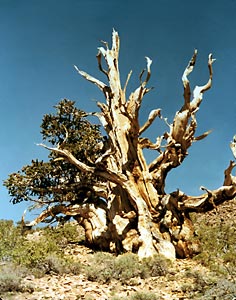
Creationists have shown experimentally with seedlings of this species, that
under the right conditions, up to 20% extra rings may grow.
These conditions might be rather infrequent. However, even that
would be sufficient to account for the 5% extra rings in the oldest living tree
that we know about. Conditions after the deluge were different.
It was wetter and warmer. The temperature of the oceans was about 80
degrees according to Creationist Michael Oard, and there was much more
precipitation —enough to extend the ice sheets of
the ice age in just a few hundred years to cover large expanses of the northern
hemisphere.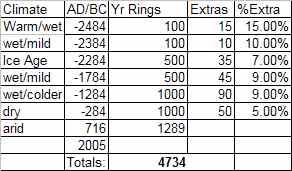
Let us suppose that over the lifetime of the tree ≈10% of the rings are double growth rings, and ≈5% of rings are missing. A tree grows rings mostly in response to wet and dry conditions and then hot and cold conditions. As little as a temporary two week drought can induce one of these tree's seedlings to put on an extra ring. The 5% missing rings were already added to the 4734 ring figure, so we only need to guess when the extra 245 rings grew. The highest rate of growth is 15% or one extra ring every seven years. The tree actually has about 4500 rings.
Evolutionary tree ring "specialists" have tried to extend the tree ring chronology beyond living specimens by "matching" dead wood they find with the living trees. C.W. Ferguson built at 7500 year bristlecone "chronology" using methods that have proven invalid in other tree ring chronologies in Europe that do not go back as far as the deluge. See this PowerPoint presentation: Tree Ring Dating and Radiocarbon. It was put together by a Seventh Day Adventist Doctor. (It should be no surprise that the creationist movement has been largely supported by the work of Sabbath keeping Christians, since the Sabbath is the memorial that God created the world in just six days, and then rested on the seventh.)
Even though tree ring "specialists" are certain about their work, the certainty is not much better than divining for water, and being certain if you dig here you will find water. The reason for this is that the tree ring students of the long bristlecone pine chronology will not release critical parts of their data, nor will they perform the control experiments necessary to validate the statistical methods used. Even with ordinary science, unscrupulous researches have tried to perpetrate a "scientific" fraud. Usually, they get caught falsifying data or massaging the numbers to fit their pre-conceived ideas. However, if they are allowed to get away with just presenting the conclusions to their research without the real data, then they can get away with the fraud longer. Trying to extend the bristlecone "chronology" and "correlate" it with radiocarbon dating was a temptation to fame to hard to resist for C.W. Ferguson. It did make him famous, but his research has not been properly evaluated for lack of public data. Here is a laundry list of the missing information:
A photographic inventory of the tree specimens used and their locations.
A list of which specimens were live trees, snags, and just dead wood on the ground.
A file with the 500 or so radiocarbon dates performed on 10 year (10 ring) sections of the chronology, and which specimens had these datings done on them, along with all pertinent data, such as error ranges supplied by the lab.
A list of the discrepant radiocarbon data. As much as 50% of radiocarbon dates can be rejected because they are discrepant with the assumed chronology of the specimen. Just how many rejected dates there were, is important to establishing a scientific control for the validity of the dating experiments. Unfortunately, many researches are not careful to keep this data and provide it, which casts grave doubt on the scientific validity of their work.
There is some published data for the long bristlecone chronology. First, there is the master chronology file, which is little more than a presentation of the conclusions. It is a list of how much the average ring width deviates from the average ring width. There is no one tree that matches that file exactly. Then there is the list of raw measurements of tree ring widths.
1. Various figures are given, 4600, 4723, 4734, 4789, 4800. The 4600 figure is actually from the National Geographic Magazine, 1958. The tree was found in 1957 and its discoverer died an early death the same year. Some of the higher figures are due to writers adding the extra years that have passed since 1957. Others have rounded off to the nearest hundred, i.e. 4700 or 4800. Return to Text.
2. Source photocopied from the Journal below: Return to Text.

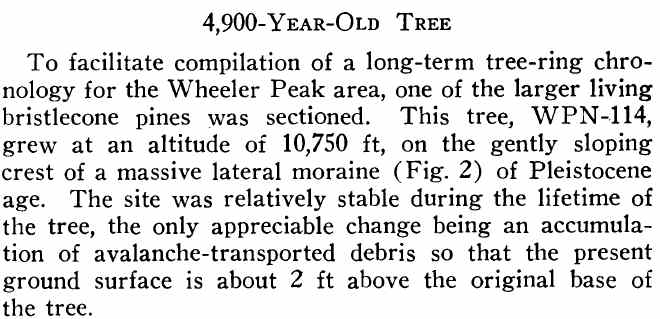
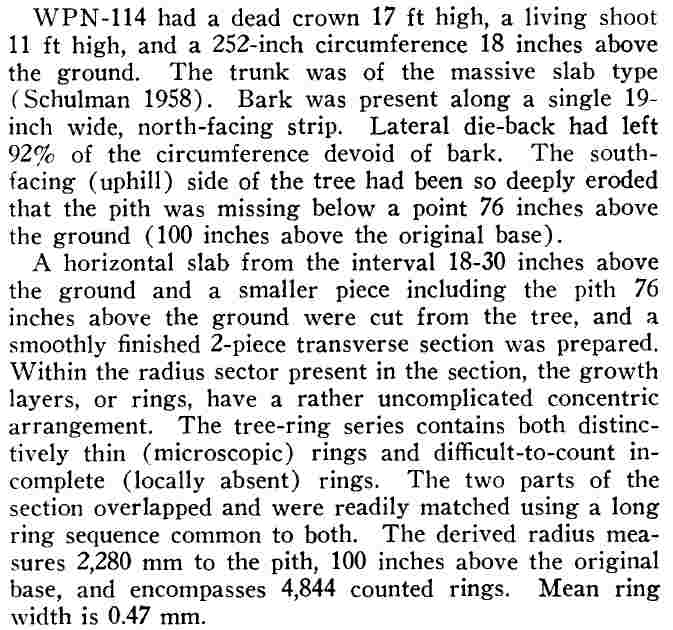
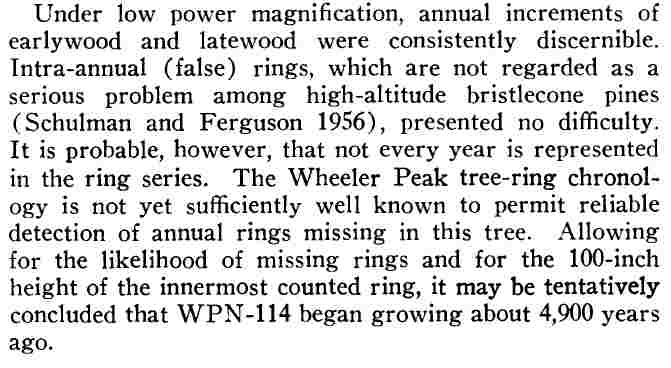
3. Lammerts, W.E., Are the Bristle-cone Pine trees really so old? Creation Research Society Quarterly 20(2):108–115, 1983. Abstract turned sideways below. Return to text.
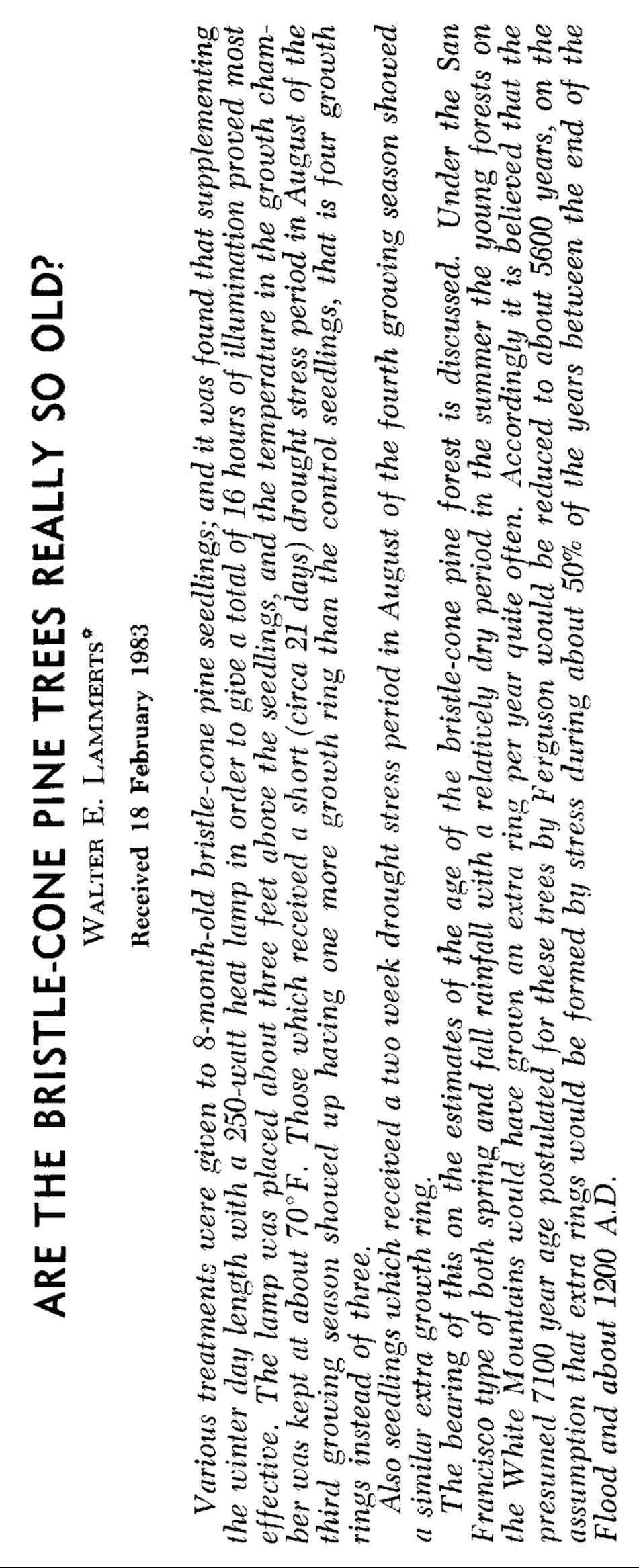
4. Glock W.S., Studhalter, R.A. and Agerter, S.R., Classification and multiplicity of growth layers in the branches of trees, Smithsonian Miscellaneous Collections 140(1):1–292, 1960. Return to text.
5. "LaMarche and Harlan claim that samples obtained in 1971 cross-match with White Mountain Bristlecone Pines sampled in 1954 by Schulman. They found that most trees have formed exactly 18 rings in the period 1954–1971 (a few formed only 17 rings, none formed more than 18 rings) indicating that the BCPs did not grow more than one ring per year. The argument hinges on a claimed cross-match that can’t be verified and could be incorrect given the inherent subjectivity of cross-matching. Beyond that, it appears that none of the living trees sampled in 1971 were ‘ancient’ ones (i.e. with thousands of rings), so it is possible that the trees in this study were growing only one ring per year. LaMarche Jr, V.C. and Harlan, T.P., Accuracy of tree ring dating of Bristlecone Pine for calibration of the radiocarbon time scale, Journal of Geophysical Research 78(36):8849–8858, 1973." Return to Text. Quoted from: http://creation.com/evidence-for-multiple-ring-growth-per-year-in-bristlecone-pines#endRef28.